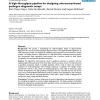168 search results - page 18 / 34 » DNA Sequence Design Using Templates |
NAR
2002
13 years 7 months ago
2002
The prediction of operons, the smallest unit of transcription in prokaryotes, is the first step towards reconstruction of a regulatory network at the whole genome level. Sequence ...
BMCBI
2008
13 years 7 months ago
2008
Background: We present a methodology for high-throughput design of oligonucleotide fingerprints for microarray-based pathogen diagnostic assays. The oligonucleotide fingerprints, ...
GECCO
1999
Springer
13 years 12 months ago
1999
Springer
Using the thermodynamics of DNA melting, a technique is proposed to choose a reaction temperature for the DNA computation that minimizes the potential for mishybridizations. Adlem...
BMCBI
2011
13 years 2 months ago
2011
Background: Genomic position (GP) files currently used in next-generation sequencing (NGS) studies are always difficult to manipulate due to their huge size and the lack of approp...
BMCBI
2006
13 years 7 months ago
2006
Background: High throughput technologies often require the retrieval of large data sets of sequences. Retrieval of EMBL or GenBank entries using keywords is easy using tools such ...

